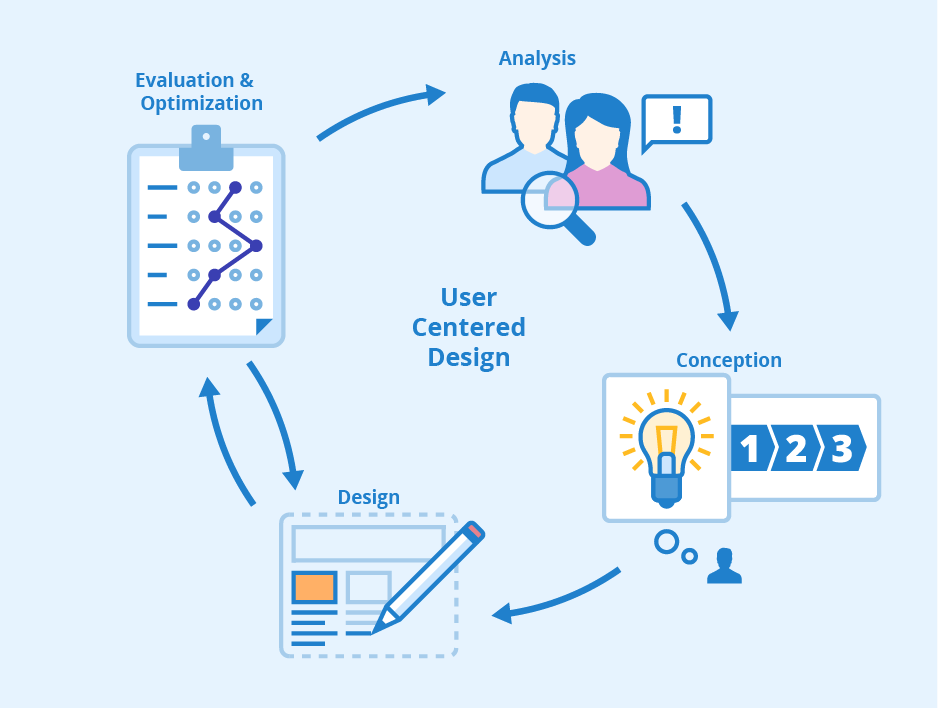In a digital world brimming with an endless sea of apps, standing out hinges on delivering not just a functional tool but an exceptional user experience. User-Centered Design (UCD) emerges as the compass that guides app developers through the tumultuous journey of creating apps that resonate deeply with users. But why exactly is UCD critical in app development, and how does it differ from human-centered design? In this article, we’ll explore the pivotal role of UCD and its distinction from human-centered design.
Understanding User-Centered Design
User-Centered Design is an iterative design process in which designers focus on the users and their needs in each phase of the design process. UCD requires a deep understanding of who the users are, what they need, what they value, their abilities, and also their limitations.
User-Centered Design Principles
UCD is grounded in the following principles:
- The design is based upon an explicit understanding of users, tasks, and environments.
- Users are involved throughout design and development.
- The design is driven and refined by user-centered evaluation.
- The process is iterative.
- The design addresses the whole user experience.
- The design team includes multidisciplinary skills and perspectives.
Benefits of User-Centered Design
The benefits of employing UCD in app development are extensive:
- Enhanced User Experience: UCD leads to products that are more intuitive and easier to use, which enhances the overall user experience.
- Increased User Satisfaction: When users feel that an app meets their needs and is easy to use, their satisfaction with the product increases.
- Reduced Development Time: By focusing on user requirements from the beginning, developers can reduce the time spent on revisions and rework.
- Lower Support Costs: Intuitive designs mean fewer user errors and a reduced need for help and support.
Human-Centered Design vs User-Centered Design
While ‘human-centered design’ and ‘user-centered design’ are terms often used interchangeably, they have subtle differences:
Human-Centered Design
Human-Centered Design (HCD) is a broader concept that not only focuses on creating products that offer an excellent user experience but also considers the broader context and impact on society. HCD takes into account the human perspective in all steps of the problem-solving process.
User-Centered Design
On the other hand, User-Centered Design is more specific in its focus on the end-user of the product. It’s a subset of HCD with a narrower scope, primarily concerned with the usability of a product and the user experience.
While both approaches aim to create products that are not only functional but also enjoyable and accessible, HCD’s scope extends to considering the product’s social and ethical implications.
The UCD Process in App Development
The UCD process typically involves several stages, each of which revolves around the end-user:
Research and Understand User Needs
Before a single line of code is written, it’s crucial to understand who will use the app and in what context. This involves user research methods such as interviews, surveys, and observations.
Design and Prototyping
Based on the insights gathered from user research, the design phase begins. This involves creating wireframes, mockups, and prototypes, which are representations of the final product.
User Testing and Feedback
Prototypes are then tested with real users to gather feedback. This user testing phase is integral to UCD as it ensures that any usability issues are identified and addressed before the final product is developed.
Refinement and Iteration
Based on user feedback, the design is refined. This iterative process continues until the product meets the usability and satisfaction criteria set by the users and the development team.
Case Studies: Success Through User-Centered Design
Spotify: Personalization at Its Core
Spotify’s success can be partly attributed to its user-centered approach to app design. The app offers personalized playlists and recommendations, which are the result of extensive user data analysis and a deep understanding of user listening habits.
Airbnb: Simplifying the Complex
Airbnb transformed the complex process of booking accommodations into a simple, user-friendly app. Their focus on user-centered design has made it easier for people to find places to stay that meet their specific needs and preferences.
Challenges in Implementing User-Centered Design
Despite the clear benefits, implementing UCD is not without challenges:
- Resource Intensive: Conducting thorough user research and testing requires time and resources.
- Requires User Participation: Finding and recruiting users to participate in research and testing can be difficult.
- Iterative Process: The iterative nature of UCD can be time-consuming, and there is a temptation to cut corners, especially under tight deadlines.
Best Practices for User-Centered Design in App Development
To effectively implement UCD in app development, consider the following best practices:
Involve Users Early and Often
Involving users from the early stages of development ensures their needs and feedback guide the design process.
Foster Multidisciplinary Collaboration
Effective UCD requires the collaboration of a team with diverse skills and perspectives, including designers, developers, and stakeholders.
Embrace Iteration
Be prepared to iterate on designs multiple times. The process of refinement is key to achieving a truly user-centered product.
Keep the Focus on User Goals
Always prioritize the user’s goals and tasks when making design decisions, rather than getting sidetracked by technological capabilities or aesthetic preferences.
The Future of User-Centered Design
As technology continues to evolve, so too will the approaches to UCD. Emerging technologies like AI and machine learning are opening up new possibilities for personalization and adaptability in app design. The future of UCD is one where apps not only meet users’ needs but anticipate them.
Conclusion
User-Centered Design is not just a nice-to-have in the realm of app development; it’s a must-have. By placing the user at the heart of the design process, developers can create apps that are not only functional but also enjoyable to use. As we look to the future, the principles of UCD will continue to guide the creation of innovative and user-friendly apps.
Incorporating UCD into the app development process may come with its challenges, but the rewards — in the form of user satisfaction, loyalty, and ultimately business success — are well worth the effort.





